Aquarium Plumbing Basics: How to Prevent Leaks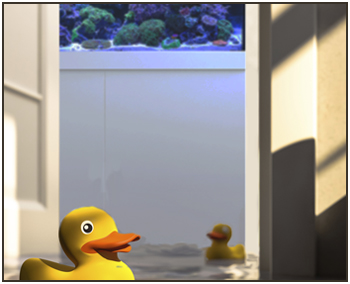
At
MarineAndReef.com the number one goal with any aquarium plumbing project is to avoid leaks. Leaks can be detrimental to animals, equipment, and homes. Here are some quick tips to avoiding leaks in your plumbing. Leaks generally occur at connection points, so we will focus on the four main types of plumbing connections you will encounter: glued/slip connections, threaded connections, hose/hose barb connections and compression seals/o-rings.
Glued/Slip Connections
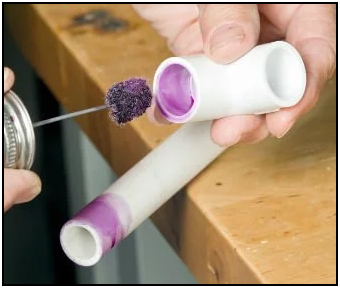
Glued connections using PVC pipe and PVC glue will last a very long time when executed properly, but they are extremely difficult to fix when they leak.
When gluing a PVC pipe into a fitting, start by making sure that the PVC pipe you cut is as smooth as possible. If you used a saw to cut your PVC, sand the edges of the cut to ensure there are no burs in the plastic. PVC cutters will make a much cleaner cut. Ensure that both the pipe and the fitting are as clean as possible. Use PVC primer or acetone to clean both sides of the connection to prepare the surfaces for gluing. When gluing the connection, add a generous amount of glue to both the fitting and the pipe and then insert and twist it into the fitting. Hold the fitting for a few seconds and then remove any excess glue with a rag and let the connection dry.
Most of the leaks in glued connections come from having rough cuts, dirty pipes, or not using enough glue.
Threaded Connections
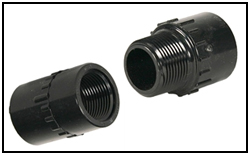
Though threaded connections are the most common cause of leaks in our experience, the process of creating a leak free threaded connection is rather simple.
Start by making sure that both the male and female threads are clean and free of burs. It can help to screw and unscrew the fittings to make sure they align well and there are no obstructions. Next, apply
Thread Seal Tape to the male threads. Some suggest using silicon sealant or plumbers putty on threaded connections. Our experience is that these liquid seals can lead to over insertion because the liquids have a lubricating effect on the threads. Threaded connections are not designed to be inserted all the way.
When using Thread Seal Tape make sure that you wrap the fitting in a clockwise direction so that the tape does not unravel as the fitting is screwed in. Not all Thread Seal Tape is created equal, so we recommend using high quality extra thick
Thread Seal Tape found on MarineandReef.com. Only three wraps of tape are necessary. Extra wraps may only serve to stress and over expand the female fitting. Once the tape has been applied you can screw the fittings together. Keep in mind that the threads should not bottom out. The threads are tapered, and it is common to have two or three threads exposed after screwing in the fitting. If you ever unscrew the fitting, reapply Thread Seal Tape as the seal is often damaged when unscrewing.
Hose/Hose Barb Connections
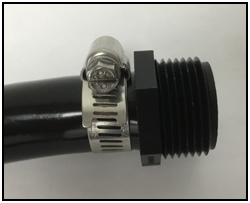
When connecting flexible tubing to hose barbs the process is rather simple, but if you donít put in due diligence hoses can slip off and cause floods.
When attaching a hose to a hose barb, start by doing your best to push the hose as far over the barb as possible. Heating up some hot water in the microwave and then dipping the end of the hose in the warm water before pushing it over the barb can help to make the hose extra supple. Once the hose has been pushed over the barb, use a
hose clamp to secure the hose. Stainless steel hose clamps are best for dry connections and plastic snapper clamps are ideal for submerged connections. When you use snapper clamps, hand squeeze the clamp together and then use a pair of pliers to get one or two more clicks.
Compressions Seals/O-Rings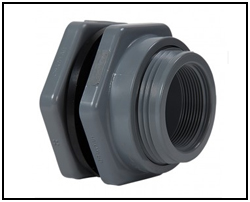
Compression seals are the seals used in bulkhead fittings, unions and canister filter lids. These fittings use an o-ring or gasket in conjunction with pressure to seal the connection. Compression seals are unique in that they are not designed to be permanent and are often at locations where you will disconnect and reconnect periodically.
When using a compression seal, it is incredibly important to make sure that the o-ring and surfaces are clean. Use a damp rag to remove any debris or dirt that could interfere with the seal. This is especially important with canister filter o-rings which will usually get dirty over time.
O-rings in compression seals can wear out over time. One way to help them last longer is to use
Lifegard Aquatics Silicone O-Ring Lubricant. You can apply silicon lubricant by taking a glob on your fingers and then running the o ring between your fingers to spread the silicon around the o ring. Once the o-ring has been lubed, you can put the o-ring in place and tighten the connection with the nut or lever. Every time you undo the connection it is a good idea to re-apply more silicone lube before resealing.































 When connecting flexible tubing to hose barbs the process is rather simple, but if you donít put in due diligence hoses can slip off and cause floods.
When connecting flexible tubing to hose barbs the process is rather simple, but if you donít put in due diligence hoses can slip off and cause floods.
